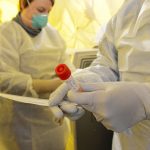For the past month, although I am a physician, I have been watching from the sidelines as many friends and colleagues have become overwhelmed caring for patients with COVID-19. As the medical director of Physicians for Human Rights (PHR), I have been working in other ways to do my part, campaigning to demand more personal protective equipment (PPE) and other measures to protect health workers, patients, and caregivers. In my own outpatient primary care clinic in Ann Arbor, Michigan, I adapted my practice to caring for all non-urgent matters virtually, and marveled at how many of my patients appreciate staying in their own home while we talk, review their medications, and discuss how they are feeling and managing their health conditions. “Why didn’t we do more virtual visits before? These are often so much better for patients,” I enthusiastically emailed my colleagues.
Now, however, I am gearing up to join the tens of thousands of health workers – physicians, nurses, respiratory therapists – who are directly caring for those at most risk of dying from COVID-19 – or continuing to care for people hospitalized for heart attacks, heart failure, and all the illnesses that don’t stop in the middle of a pandemic. Here in southeast Michigan, we watched with horror as elsewhere in the country the number of people with severe cases of COVID grew exponentially. But now, after what was only a few extra days, the surge is here, too.
The patients I encounter in the coming days and weeks will have access to standards of medical care that the tens of thousands of migrants who are being forced to wait at the U.S. border as a direct result of U.S policies or who are being held in U.S. immigration detention centers can only dream of.
Like many other physicians who have not provided inpatient hospital care for years or decades, I will soon report to join the health care workers who have been working around the clock in local hospitals. Our colleagues initially cared for a trickle of cases, now for the overflow from the already-full hospitals in Detroit, and soon for the projected explosion of cases in the coming weeks. The notice of my assignment explains that those of us redeployed to inpatient care will be expected to work in the hospital a week at a time over the next months. I will put on hold my research, teaching, work for PHR. It’s a transition I could not have imagined just a month ago. But it reflects how the pandemic and the necessary societal response to it has upended the lives of all of us.
It’s still unclear whether I will be assigned to a floor dedicated to the treatment of COVID-19 patients or will instead treat patients with other health issues. If assigned to work in an intensive care unit, I am assured that I will be paired with an experienced critical care doctor. I feel reassured by that, and also by knowing that the nurses are all outstanding and highly experienced. As during my internal medicine residency, everybody will pull together. But I still fretfully wonder if I have enough hours to read all the preparatory materials our hospital has provided to prepare those of us who have devoted our last decades of clinical work to outpatient primary care.
I recognize though that – for now, at least – I am in a fortunate position compared to many of my colleagues in New York City – the U.S. epicenter of the outbreak – as well as in many other parts of the country, including nearby Detroit. And we are in an incomparably fortunate position compared to many places around the world, especially where health systems are weak or almost nonexistent. For now, the growth in expected cases here is in line with the hospital’s careful modeling. There has clearly been extensive planning and preparation over the past weeks. Our clinical leadership send daily emails to all of us on faculty and staff with clear and thorough updates. And, as important, there appear to be no imminent shortages of PPE, such as N95 masks and surgical gowns for health workers, or ventilators for those patients who need them.
I am acutely aware that the current resources at our hospital far outstrip those of hospitals in countries shattered by war and conflict. And that there are essentially no resources now to help populations around the world who are at high risk, such as the Rohingya refugees in Bangladesh or the internally displaced Syrians in the besieged northwest of their country. I am also acutely aware that the patients I encounter in the coming days and weeks will have access to standards of medical care that the tens of thousands of migrants who are being forced to wait at the U.S. border as a direct result of U.S policies or who are being held in U.S. immigration detention centers can only dream of. Moreover, most of the patients I will care for are not undocumented or recent immigrants. They thus do not live in fear that by accessing necessary medical care they will be deported or blocked from changes in their immigration status under the recently enacted Public Charge Rule, a new rule stating that individuals who use certain public benefits can be denied legal residence documentation.
What I share with physicians and other health professionals worldwide is outrage about how COVID-19 misinformation has spread and imbued the general public with deep anxiety and mistrust. While state and local leadership in Michigan has responded to the pandemic with clear information and vigorous protections, I remain frustrated and angry at the lack of strong and consistent federal leadership and transparency that a national and global public health crisis demand. And I fear for colleagues, friends, loved ones, and acquaintances who I know are particularly susceptible to the virus because of their age, underlying conditions, or inability to access the care they will need.

